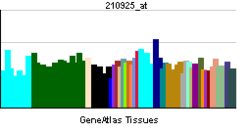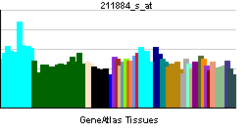CIITA
| View/Edit Human | View/Edit Mouse |
CIITA is a human gene which encodes a protein called the class II, major histocompatibility complex, transactivator.[4] Mutations in this gene are responsible for the bare lymphocyte syndrome in which the immune system is severely compromised and cannot effectively fight infection.[4] Chromosomal rearrangement of CIITA is involved in the pathogenesis of Hodgkin lymphoma and primary mediastinal B cell lymphoma.[5]
Function
CIITA mRNA can only be detected in human leukocyte antigen (HLA) system class II-positive cell lines and tissues. This highly restricted tissue distribution suggests that expression of HLA class II genes is to a large extent under the control of CIITA.[6] However CIITA does not appear to directly bind to DNA.[6] Instead CIITA functions through activation of the transcription factor RFX5.[7] Hence CIITA is classified as a transcriptional coactivator.
The CIITA protein contains an acidic transcriptional activation domain, 4 LRRs (leucine-rich repeats) and a GTP binding domain.[8] The protein uses GTP binding to facilitate its own transport into the nucleus.[9] Once in the nucleus, the protein acts as a positive regulator of class II major histocompatibility complex gene transcription, and is often referred to as the "master control factor" for the expression of these genes.[10][11]
Interactions
CIITA has been shown to interact with:
See also
References
- ↑ "Diseases that are genetically associated with CIITA view/edit references on wikidata".
- ↑ "Human PubMed Reference:".
- ↑ "Mouse PubMed Reference:".
- 1 2 Steimle V, Otten LA, Zufferey M, Mach B (Oct 1993). "Complementation cloning of an MHC class II transactivator mutated in hereditary MHC class II deficiency (or bare lymphocyte syndrome)". Cell. 75 (1): 135–46. doi:10.1016/S0092-8674(05)80090-X. PMID 8402893.
- ↑ Steidl C, Shah SP, Woolcock BW, Rui L, Kawahara M, Farinha P, Johnson NA, Zhao Y, Telenius A, Neriah SB, McPherson A, Meissner B, Okoye UC, Diepstra A, van den Berg A, Sun M, Leung G, Jones SJ, Connors JM, Huntsman DG, Savage KJ, Rimsza LM, Horsman DE, Staudt LM, Steidl U, Marra MA, Gascoyne RD (Mar 2011). "MHC class II transactivator CIITA is a recurrent gene fusion partner in lymphoid cancers". Nature. 471 (7338): 377–81. doi:10.1038/nature09754. PMID 21368758.
- 1 2 Mach B, Steimle V, Reith W (Apr 1994). "MHC class II-deficient combined immunodeficiency: a disease of gene regulation". Immunological Reviews. 138 (1): 207–21. doi:10.1111/j.1600-065X.1994.tb00853.x. PMID 8070816.
- 1 2 Scholl T, Mahanta SK, Strominger JL (Jun 1997). "Specific complex formation between the type II bare lymphocyte syndrome-associated transactivators CIITA and RFX5". Proceedings of the National Academy of Sciences of the United States of America. 94 (12): 6330–4. doi:10.1073/pnas.94.12.6330. PMC 21049
 . PMID 9177217.
. PMID 9177217. - ↑ Raval A, Howcroft TK, Weissman JD, Kirshner S, Zhu XS, Yokoyama K, Ting J, Singer DS (Jan 2001). "Transcriptional coactivator, CIITA, is an acetyltransferase that bypasses a promoter requirement for TAF(II)250". Molecular Cell. 7 (1): 105–15. doi:10.1016/S1097-2765(01)00159-9. PMID 11172716.
- ↑ Harton JA, Cressman DE, Chin KC, Der CJ, Ting JP (Aug 1999). "GTP binding by class II transactivator: role in nuclear import". Science. 285 (5432): 1402–5. doi:10.1126/science.285.5432.1402. PMID 10464099.
- ↑ Harton JA, Ting JP (Sep 2000). "Class II transactivator: mastering the art of major histocompatibility complex expression". Molecular and Cellular Biology. 20 (17): 6185–94. doi:10.1128/MCB.20.17.6185-6194.2000. PMC 86093
 . PMID 10938095.
. PMID 10938095. - ↑ LeibundGut-Landmann S, Waldburger JM, Krawczyk M, Otten LA, Suter T, Fontana A, Acha-Orbea H, Reith W (Jun 2004). "Mini-review: Specificity and expression of CIITA, the master regulator of MHC class II genes". European Journal of Immunology. 34 (6): 1513–25. doi:10.1002/eji.200424964. PMID 15162420.
- 1 2 Voong LN, Slater AR, Kratovac S, Cressman DE (Apr 2008). "Mitogen-activated protein kinase ERK1/2 regulates the class II transactivator". The Journal of Biological Chemistry. 283 (14): 9031–9. doi:10.1074/jbc.M706487200. PMC 2431044
 . PMID 18245089.
. PMID 18245089. - ↑ Tzortzakaki E, Spilianakis C, Zika E, Kretsovali A, Papamatheakis J (Dec 2003). "Steroid receptor coactivator 1 links the steroid and interferon gamma response pathways". Molecular Endocrinology. 17 (12): 2509–18. doi:10.1210/me.2002-0439. PMID 12933903.
- 1 2 Hake SB, Masternak K, Kammerbauer C, Janzen C, Reith W, Steimle V (Oct 2000). "CIITA leucine-rich repeats control nuclear localization, in vivo recruitment to the major histocompatibility complex (MHC) class II enhanceosome, and MHC class II gene transactivation". Molecular and Cellular Biology. 20 (20): 7716–25. doi:10.1128/mcb.20.20.7716-7725.2000. PMC 86349
 . PMID 11003667.
. PMID 11003667. - ↑ Nekrep N, Geyer M, Jabrane-Ferrat N, Peterlin BM (Aug 2001). "Analysis of ankyrin repeats reveals how a single point mutation in RFXANK results in bare lymphocyte syndrome". Molecular and Cellular Biology. 21 (16): 5566–76. doi:10.1128/MCB.21.16.5566-5576.2001. PMC 87278
 . PMID 11463838.
. PMID 11463838. - ↑ Raval A, Weissman JD, Howcroft TK, Singer DS (Jan 2003). "The GTP-binding domain of class II transactivator regulates its nuclear export". Journal of Immunology. 170 (2): 922–30. doi:10.4049/jimmunol.170.2.922. PMID 12517958.
- ↑ Al-Kandari W, Jambunathan S, Navalgund V, Koneni R, Freer M, Parimi N, Mudhasani R, Fontes JD (Jan 2007). "ZXDC, a novel zinc finger protein that binds CIITA and activates MHC gene transcription". Molecular Immunology. 44 (4): 311–21. doi:10.1016/j.molimm.2006.02.029. PMC 1624858
 . PMID 16600381.
. PMID 16600381. - ↑ Al-Kandari W, Koneni R, Navalgund V, Aleksandrova A, Jambunathan S, Fontes JD (Jun 2007). "The zinc finger proteins ZXDA and ZXDC form a complex that binds CIITA and regulates MHC II gene transcription". Journal of Molecular Biology. 369 (5): 1175–87. doi:10.1016/j.jmb.2007.04.033. PMC 1963517
 . PMID 17493635.
. PMID 17493635.
External links
- MHC class II transactivator protein at the US National Library of Medicine Medical Subject Headings (MeSH)
This article incorporates text from the United States National Library of Medicine, which is in the public domain.

